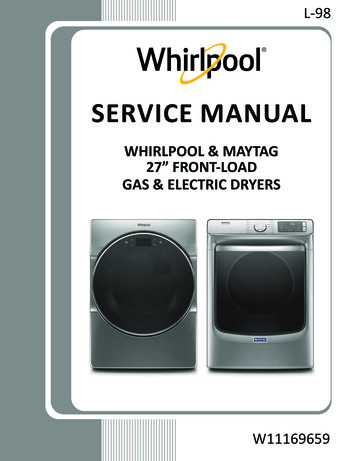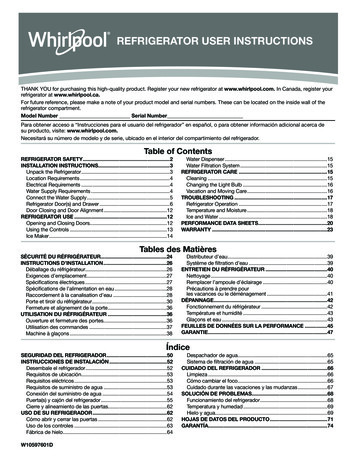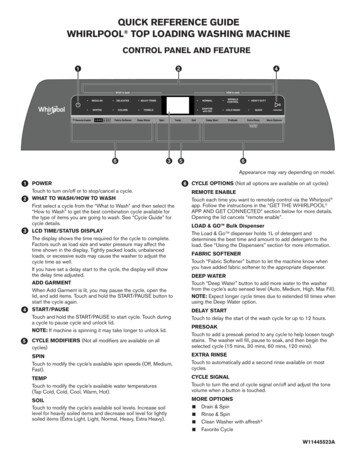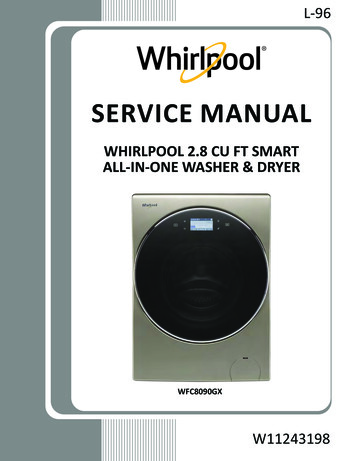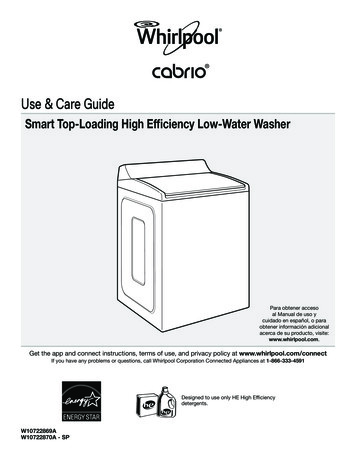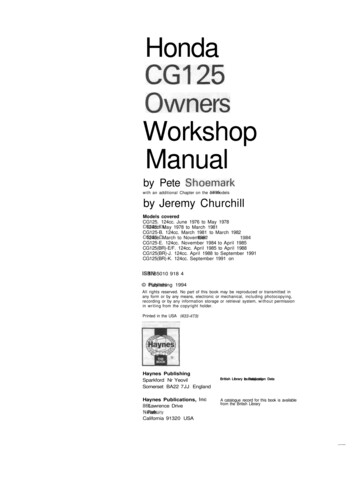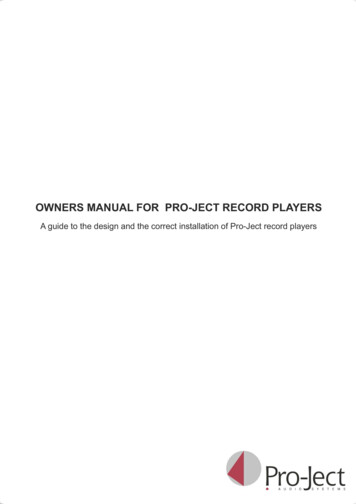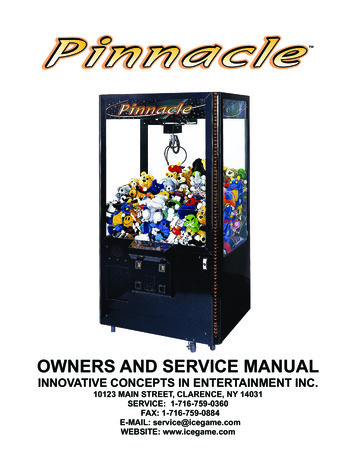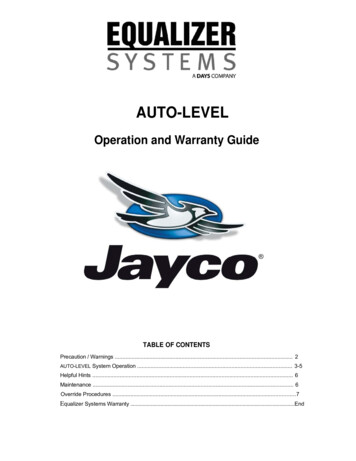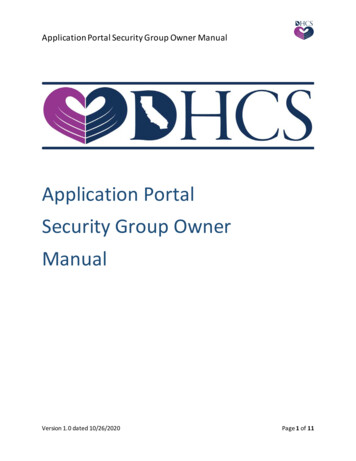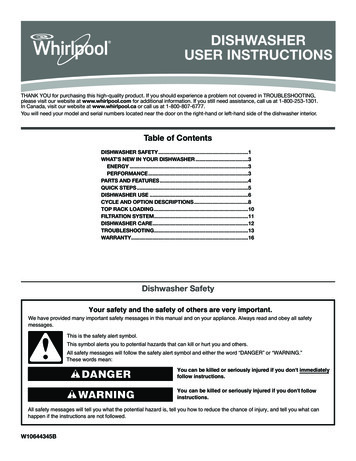
Transcription
DISHWASHERUSER INSTRUCTIONSTHANK YOU for purchasing this high-quality product. If you should experience a problem not covered in TROUBLESHOOTING,please visit our website at www.whirlpool.com for additional information. If you still need assistance, call us at 1-800-253-1301.In Canada, visit our website at www.whirlpool.ca or call us at 1-800-807-6777.You will need your model and serial numbers located near the door on the right-hand or left-hand side of the dishwasher interior.Table of ContentsDISHWASHER SAFETY.1WHAT’S NEW IN YOUR DISHWASHER.3ENERGY.3PERFORMANCE.3PARTS AND FEATURES.4QUICK STEPS.5DISHWASHER USE.6CYCLE AND OPTION DESCRIPTIONS.8TOP RACK LOADING.10FILTRATION SYSTEM.11DISHWASHER CARE.12TROUBLESHOOTING.13WARRANTY.16Dishwasher SafetyYour safety and the safety of others are very important.We have provided many important safety messages in this manual and on your appliance. Always read and obey all safetymessages.This is the safety alert symbol.This symbol alerts you to potential hazards that can kill or hurt you and others.All safety messages will follow the safety alert symbol and either the word “DANGER” or “WARNING.”These words mean:DANGERWARNINGYou can be killed or seriously injured if you don't immediatelyfollow instructions.You can be killed or seriously injured if you don't followinstructions.All safety messages will tell you what the potential hazard is, tell you how to reduce the chance of injury, and tell you what canhappen if the instructions are not followed.W10644345B
IMPORTANT SAFETY INSTRUCTIONSWARNING: When using the dishwasher, follow basic precautions, including the following: Read all instructions before using the dishwasher.Use the dishwasher only for its intended function.Use only detergents or rinse agents recommended for use ina dishwasher, and keep them out of the reach of children.When loading items to be washed:1) Locate sharp items so that they are not likely to damagethe door seal; and2) Load sharp knives with the handles up to reduce the riskof cut-type injuries.Do not wash plastic items unless they are marked“dishwasher safe” or the equivalent. For plastic items not somarked, check the manufacturer's recommendations.Do not touch the heating element during or immediately afteruse.Do not operate the dishwasher unless all enclosure panelsare properly in place. Do not tamper with controls.Do not abuse, sit on, or stand on the door, lid, or dish racksof the dishwasher.To reduce the risk of injury, do not allow children to play inor on the dishwasher.Under certain conditions, hydrogen gas may be produced ina hot water system that has not been used for two weeks ormore. HYDROGEN GAS IS EXPLOSIVE. If the hot watersystem has not been used for such a period, before usingthe dishwasher turn on all hot water faucets and let thewater flow from each for several minutes. This will releaseany accumulated hydrogen gas. As the gas is flammable,do not smoke or use an open flame during this time.Remove the door or lid to the washing compartmentwhen removing an old dishwasher from service ordiscarding it.SAVE THESE INSTRUCTIONSGROUNDING INSTRUCTIONS For a grounded, cord-connected dishwasher:The dishwasher must be grounded. In the event of amalfunction or breakdown, grounding will reduce the risk ofelectric shock by providing a path of least resistance forelectric current. The dishwasher is equipped with a cordhaving an equipment-grounding conductor and a groundingplug. The plug must be plugged into an appropriate outletthat is installed and grounded in accordance with all localcodes and ordinances.WARNING: Improper connection of the equipment-grounding conductor can result in a risk of electric shock. Check with a qualified electrician or service representativeif you are in doubt whether the dishwasher is properlygrounded. Do not modify the plug provided with thedishwasher; if it will not fit the outlet, have a proper outletinstalled by a qualified electrician.For a permanently connected dishwasher:The dishwasher must be connected to a grounded metal,permanent wiring system, or an equipment-groundingconductor must be run with the circuit conductors andconnected to the equipment-grounding terminal or lead onthe dishwasher.SAVE THESE INSTRUCTIONSWARNINGTip Over HazardDo not use dishwasher until completely installed.Do not push down on open door.Doing so can result in serious injury or cuts.2
What’s New in Your DishwasherEnergyCongratulations on purchasing your water and energy efficient dishwasher! This dishwasher cleans by sprayingthe dishes with water and pauses to allow the detergent to soak into and release the soils on the dishes. The cyclesare longer due to the soak and pauses for exceptional cleaning. Several models contain an optical water sensor. Theoptical water sensor is used to determine the optimum water and energy consumption for great cleaning performance.Efficient dishwashers run longer to save water and energy, just as driving a car slower saves on gas. The first cycleusing the sensor will run longer to calibrate the optical sensor.PerformanceRinse AidUsing rinse aid will optimize your drying and wash performance.This dishwasher is specifically designed to be used with rinse aidfor improved drying performance and controlling buildup of hardwater deposits. Energy efficient dishwashers use less water andenergy, so they depend on the water “sheeting” action of rinse aidfor total optimal performance.DetergentThe United States and Canada have passed a restrictionlimiting the amount of phosphorus (phosphates) in thehousehold dishwasher detergents. Major manufacturers havereformulated their dishwasher detergent for this change indetergents as another step in eco-conscious awareness. Withthese recent changes it is recommended to use tablets andpacks for convenience and improved performance.Filtration SystemYour dishwasher has the latest technology in dishwasherfiltration. This triple filtration system minimizes sound andoptimizes water and energy conservation while providingoptimal cleaning performance. Maintenance of your filtersregularly will sustain peak cleaning performance. We suggestyou clean both your upper and lower filter and rinse underrunning water at least once a month.LOCPUKSH DOWN & TURNLUNOCK3
Parts and Features4
Quick Steps1Prepare and loaddishwasher.4Start dishwasher.5Unload and cleanthe filter.Spin the sprayarms. Theyshould turnfreely.2Add detergent and rinse aid.Push door firmly closed. Thedoor latches automatically.Select the wash cycle optionsand press START/RESUME orpress START/RESUME to repeatthe same cycle and options as inthe previous wash cycle.NOTE: If the Start/Resumebutton is located on the top ofdoor, push door firmly closedwithin 4 seconds of pressingStart/Resume.PUSH DOWN &TURNLOCSee “RecommendedTime Interval to CleanYour Filter,” in the“Filtration System”section for therecommendedcleaning schedule.KKUNLOC3Select a cycle and option (cycles and optionsvary by model).5
Dishwasher UseSTEP 1STEP 2Prepare and Load the DishwasherAdd DetergentIMPORTANT: Remove leftover food, bones, toothpicks, andother hard items from the dishes. Remove labels from containersbefore washing.NOTE: If you do not plan to run a wash cycle soon, run a rinsecycle. Do not use detergent. Fresh automaticdishwasher detergentresults in better cleaning.Store tightly closeddetergent containerin a cool, dry place.Make sure nothing keeps spray arm(s) fromspinning freely. It is important for the waterspray to reach all soiled surfaces. Make sure that when the dishwasher dooris closed and no items are blocking thedetergent dispenser. Items should be loaded with soiled surfacesfacing down and inward to the spray as shown in the graphicsabove. This will improve cleaning and drying results. Avoid overlapping items, like bowls or plates, that maytrap food. Place plastics, small plates, and glasses in the upper rack. Wash only items marked “dishwasher safe.” To avoid thumping/clattering noises during operation:Load dishes so they do not touch one another. Makesure lightweight load items are secured in the racks. When loading silverware, always place sharpitems pointing down and avoid “nesting” asshown. If your silverware does not fit into thedesignated slots, flip the covers up and mixsilverware types to keep them separated.Use suggested loading patterns, asshown, to better clean your silverware.Use the slots in the covers to keep yoursilverware separated for optimum wash.ABFor optimum performance,tablet detergent isrecommended. The amount of detergentA. Cover latchto use depends on:B. Main wash sectionHow much soil remainsC. Pre-wash sectionon the items – Heavily soiledloads require more detergent.The hardness of the water – If you use too little detergent inhard water, dishes won’t be clean. If you use too much in softwater, glassware will etch.Soft to Medium Water (0–6 grains per U.S. gallon)[typical water softener water and some city water]Medium to Hard Water (7–12 grains per U.S. gallon)[well water and some city water]Depending on your water hardness, fill the Main Wash sectionof the dispenser as shown. Fill the Pre-Wash section to thelevel shown for heavily soiled items.NOTE: Fill amounts shown are for standard powdered detergent.Follow instructions on the package when using other dishwasherdetergent. Hard WaterSoft WaterMain WashPre-WashAdd Rinse Aid Your dishwasher is designed to use rinse aid for good dryingperformance. Without rinse aid, your dishes and dishwasherinterior will have excessive moisture. The Heat Dry option willnot perform as well without rinse aid. Rinse aid keeps water from forming dropletsthat can dry as spots or streaks. They alsoimprove drying by allowing water to drainoff of the dishes after the final rinse. Check the rinse aid indicator. Add rinse aidwhen indicator drops to “Add” level. To add rinse aid, turn the dispenser cap1/4 turn counterclockwise and lift off.Pour rinse aid into the opening until theindicator level is at “Full.” Replace thedispenser cap and turn to “Lock.”Make sure cap is fully locked.FullAddLock---6543llfi21---- -6CPREWASHMAIN WASH Lower Rack Use automatic dishwasher detergent only. Add powder,liquid, or tablet detergent just before starting a cycle.maxUpper Rack - - - - -
NOTE: For most water conditions, the factory setting will givegood results. Check water hardness level to ensure there are no rings orspots on your dishware before adding rinse aid or adjustingthe factory setting.If you have hard water or notice rings or spots, trya higher setting.Turn the arrow adjuster inside thedispenser by either using your fingers or-llfiinserting a flat-blade screwdriver into thecenter of the arrow and turning.Start or Resume a Cycle Run hot water at the sink nearest to your dishwasher until thewater is hot. Turn off water. For best dishwashing results, water should be 120ºF (49ºC)as it enters the dishwasher. Push door firmly closed. The door latches automatically.Select the wash cycle, options and press START/RESUME orpress START/RESUME to repeat the same cycle and optionsas in the previous wash cycle.For models with controls on top of the door, select washcycle, option, and press START/RESUME within 4 secondsof closing the door. You can add an item anytime at the beginning of the cycle.Open the door slowly and add the item. Close the door firmly.Press START/RESUME.max STEP 4---- --- - - -STEP 3Select a Cycle (cycles vary by model)See “Cycle and Option Descriptions” charts in the following section.Heavier cycles and options affect cycle length.Select Options (options vary by model)See “Cycle and Option Descriptions” charts in the following section.You can customize your cycles by pressing the options desired.7
Cycle and Option DescriptionsThis information covers several different models. Your dishwasher may not have all of the cycles and options described. Estimatedcycle times may increase or decrease depending on water temperature, soil conditions, dish load size, and options selected. You cancustomize your cycle by selecting an option.See option selections. If you change your mind, press the option again to turn off the option or select a different option. You can changean option anytime before the selected option begins. At each stage of the wash cycle, you may hear noises that you are not used tohearing in your previous dishwasher. Each cycle will provide a series of pauses and water sprays throughout the wash cycle. This isnormal and will provide optimal cleaning performance.CYCLE SELECTIONSCYCLESESTIMATEDWASH TIME(HH:MM)WATER USAGEGALLONS(LITERS)Use for hard-to-clean, heavily soiled pots, pans, casseroles, and tableware.3:287.4(28.1)This cycle with only the Heat Dry option selected, and without other options selected,is recommended to completely wash and dry a full load of normally soiled dishes. Theenergy usage label is based on this cycle and option combination.2:322.4 to 7.4(9.09 to 28)For fast results, 1 Hr Wash will clean dishes using slightly more water and energy.Select the Heat Dry option to provide best drying performance.1:007.87 (29.8)IMPORTANT: The sensor in your dishwasher monitors the soil level. Cycle time and/or water usage can vary as the sensor adjusts thecycle for the best wash performance. If the incoming water is less than the recommended temperature or food soils are heavy, the cyclewill automatically compensate by adding time, heat, and water as needed.OPTION SELECTIONSOPTIONS8CAN BESELECTEDWITHWHAT IT DOESADDED TIMETO CYCLEADDEDWATERGALLONS(LITERS)High Temp raises main wash temperature to improvecleaning for loads containing tough, baked-on food.All cyclesRaises the mainwash temperatureto 135 F (57 C).0:05 to 0:130 to 3.86(0 to 14.6)Heat Dry dries dishes with heat. This option, withthe use of rinse aid, will provide the best dryingperformance. Plastic items are less likely to deformwhen loaded in the top rack. Use Heat Dry foroptimum drying performance. Turn the Heat Dryoption off for air dry.All cyclesUses heatingelement to speeddrying times.Heat Dry optiondefaults to onwhen any cycle isselected exceptfor 1 Hr Wash.0:08 to 0:460
OPTION SELECTIONSOPTIONSCAN BESELECTEDWITHRuns dishwasher at a later time. Select a washcycle and options. Each time you press theDelay button, it will display the next available delaytime. Press 4 HR DELAY. Press START/RESUME.Close door firmly.NOTES: The dishwasher remembers the last Delay youselected. To reset the Delay time to somethingother than what is displayed, continue to pressthe Delay button until the desired delay timeis reached. Anytime the door is opened (such as, to adda dish), Start/Resume must be pressed againto resume delay countdown.Available withany cycleWHAT IT DOES ADDED TIMETO CYCLEDelay 4 hours0:00ADDEDWATERGALLONS(LITERS)0To turn on lock, press and hold 4 HR DELAY for 3 seconds. Control Lock light will stay on for a short time, indicatingthat it is activated and all buttons are disabled. If you press any button while your dishwasher is locked, a lightflashes three times. Dishwasher door can still be opened/closed while the controls are locked.To turn off Lock, press and hold 4 HR DELAY for 3 seconds. Light turns off.CONTROLS AND CYCLE STATUSCONTROLPURPOSECOMMENTSPress to start or resume a wash cycle.If the door is opened during a cycle or the power is interrupted, the Start/Resume button LED flashes.Cycle will not resume until door is closed and Start/Resume is pressed.Press to cancel wash cycle.Close the door firmly. The dishwasher starts a 2-minute drain (if needed). Let dishwasher draincompletely. Press CANCEL again to fully cancel machine.The Clean indicator glows when a cycle is finished.9
Top Rack LoadingLoading RecommendationsPlace cups and glasses in the rows between tines. Placing them over the tines can lead tobreakage and water spots. To avoid damage to your delicate items, be sure china, crystal,stemware and other similar items do not touch during dishwasher operation.Load lightweight and dishwasher-safe plastic items only in the top rack.10-place loadRemovable Top RackThe removable rack allows you to wash larger items, such as stock pots, roasters and cookie sheets, in the lower level rack.IMPORTANT: Remove dishes prior to removing the upper rack from the dishwasher.To remove the rack (push tab rack stop):1. Roll the rack 1/3 to 1/2 of the way out.2. Remove each plastic push tab rack stop from the end of each track by pushing inward towardthe rack on the ridged area of the rack stop. The rack stop will snap open and can be easilyremoved by pulling straight out. Be sure to support the track while removing rack stops.3. Roll the rack all the way out of the track and remove from the dishwasher.To replace the rack:Reverse the above steps 1 through 3 to replace the rack into the dishwasher.10
Filtration SystemYour dishwasher has the latest technology in dishwasher filtration. This triple filtration system minimizes sound and optimizes waterand energy conservation while providing superior cleaning performance. Throughout the life of your dishwasher, the filter will requiremaintenance to sustain peak cleaning performance.The triple filter system consists of two parts, an upper filterassembly and a lower filter. The upper filter assembly keeps oversized items and foreignobjects, along with very fine food particles, out of the pump. The lower filter keeps food from being recirculated ontoyour dishware. The filters may need to be cleaned when: Visible objects or soils are on the upper filter assembly. There is degradation in cleaning performance (that is, soilsstill present on dishes). Dishes feel gritty to the touch.It is very easy to remove and maintain the filters. The chart belowshows the recommended cleaning frequency.RECOMMENDED TIME INTERVAL TO CLEAN YOUR FILTERNumber of Loads If you only scrape before loading*Per WeekIf you scrape and rinse before loadingIf you wash before loading8-12Every two monthsEvery four monthsOnce per year4-7Every four monthsOnce per yearOnce per year1-3Twice per yearOnce per yearOnce per year*Manufacturer’s recommendation: This practice will conserve the water and energy that you would have used to prepare your dishes.This will also save you time and effort.Very Hard WaterCleaning InstructionsIf you have hard water (above 15 grains), clean your filter at leastonce per month. Building up of white residue on your dishwasherindicates hard water. For tips on removing spots and stains, seethe “Troubleshooting” section.IMPORTANT: Do not use wire brush, scouring pad, etc., as theymay damage the filters.Rinse filter under running water until most soils are removed.If you have hard-to-remove soils or calcium deposits from hardwater, a soft brush may be required.Filter Removal Instructions1. Turn the upper filter assembly1/4 turn counterclockwise andlift out.2. Separate the upper filterassembly by gently pullingapart.3. Clean the filters as shown.PUSH DOWN &TURNLOLOCPUKCKSH DOWN & TURNKUNLOCLUNOCKTo remove upper filter assembly11
Filter Reinstallation Instructions3. Slowly rotate the filterclockwise until it dropsinto place.
marked, check the manufacturer's recommendations. Do not touch the heating element during or immediately after use. Do not operate the dishwasher unless all enclosure panels are properly in place. Do n
